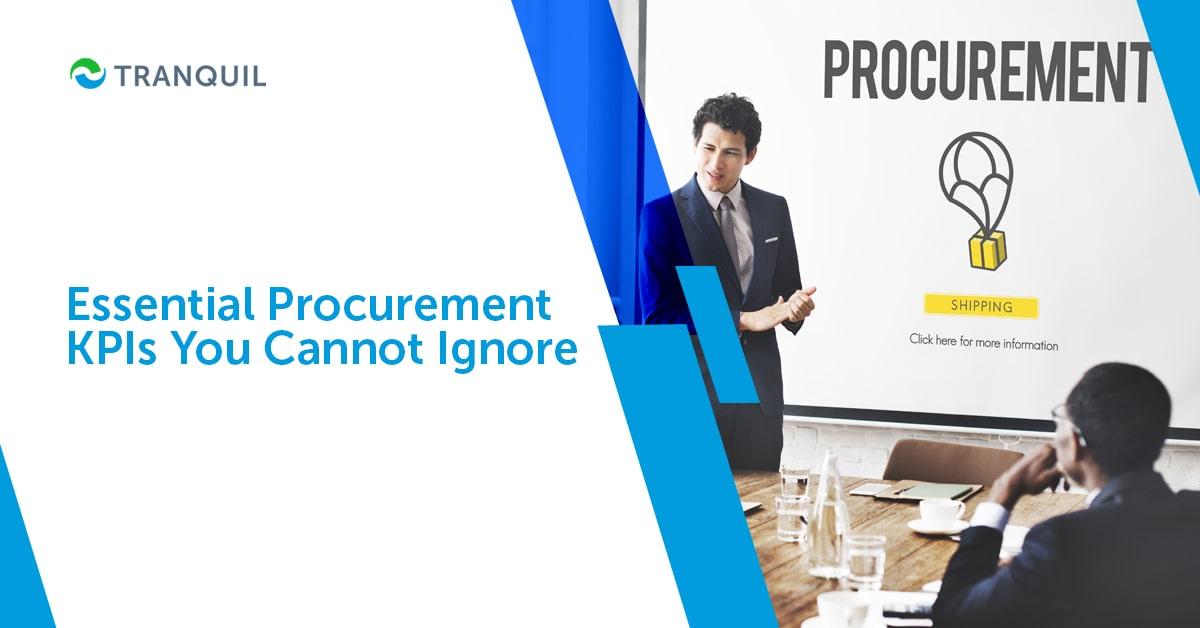
Cost savings is not the only value that companies demand from their procurement teams, and this has led to them always being on the lookout for means to enhance their procurement process and ensure its sustainability.
They need to monitor a range of procurement KPIs so that they can make
But while procurement KPIs are measured by almost all procurement teams across industries; however, they are not cut and dried.
Different businesses may accord different importance to each purchasing KPI.
In fact, most of the times, procurement teams are not really aware of what element is a KPI and what isn’t.
So, when the time comes to make decisions and track performance, how can you ensure that the most metrics that are most relevant to the business are being tracked?
For this, you need to understand the numerous procurement KPIs that leaders in the industry use.
ALSO READ: Ways to Improve Procurement process
Procurement key performance indicators are used as tools to measure the performance of a company with regard to procurement management.
They can help businesses in the optimization and regulation of cost, time, quality, etc.
Procurement KPIs also enable businesses to stay in step with their overarching business objectives, procurement strategies, and process goals.

Peter Drucker, regarded as one of the foremost management gurus had said that what cannot be measured, cannot be improved – and it is true.
Without knowing how you are doing how will you improve your performance.
Procurement plays an important part in the supply chain, especially in times of economic slump.
In addition to saving money, measuring purchasing metrics can help you find out what needs to be improved, whether your business is improving, and how your business compares with other businesses.
It can also help in:
While cost savings are an obvious objective of procurement performance, it is not just restricted to that.
ALSO READ: Procurement vs Purchasing
By measuring the performance of a procurement process, organizations can find answers to other important questions like:
The appropriate metrics are those that are pertinent to your business goals and can be easily tracked.
Understand the purpose of various KPIs before deciding which ones actually are relevant for your business.
KPIs can be categorized by what they improve, like Quality, Delivery, and Cost Savings KPIs, or by which party it scrutinizes, like Vendor, Employee, and Organizational KPIs.
ALSO READ: Debit Note vs Credit Note
Let’s check out the most commonly used and important procurement metrics:
Complying with policies and contracts are crucial for ensuring legal security.
If your compliance rate falls, it can lead to a rise in indiscriminate spending.
To improve the compliance rate, you should have a watertight purchase contract with well-defined penalties.
You should note these metrics: the difference between quoted and paid price, and the ratio of disputed invoices to total invoices.
ALSO READ: Challenges in Procurement and Supply Chain
This ratio helps in assessing the quality of a vendor.
Measuring the defect rates and separating them on type of defect can demonstrate how reliable a vendor is.
Supplier defects are normally measured per million.
Defect rate = number of defective products/ total number of products tested

Your operating expenses can be vastly increased if your PO accuracy is low.
This basically tests how reliable your vendors are in delivering what you ordered, and whether they delivered it in time (supplier/vendor quality metric).
You must monitor the ratio of goods and services delivered beyond the service target agreed upon, and the percentage of incorrect deliveries over the total number of purchase orders in a specific period.
ALSO READ: What is P2P (Procure to Pay) Process?
These are unplanned orders you are forced to make to be able to meet production or sales requirements.
These tend to be very expensive.
The lower this number, the better for your business.
You can measure this metric by comparing the number of emergency purchases to the total number of purchases made in a fixed time period.
You can ensure continuity, save money, decrease the risk of supply, and improve your procurement strategy by reducing your emergency purchase rate.
This is simply the time the vendor takes from the time of receiving an order to delivering the goods and is measured in number of days.
The confirmation of the availability of goods is the start time, and the delivery of goods to the customer is the end time. This is a supplier quality metric.
ALSO READ: Sales Order vs Purchase Order

PO cycle time refers to the time it takes for a purchase requisition that is submitted, to be sent to a vendor or supplier, and is measured in hours or days.
It covers the ordering process from start to finish. It includes creating the order, approving, generating the invoice, delivering, and payments.
From this KPI you can identify which vendor responds the quickest. You can divide them into different categories depending on the cycle time, like short, medium, and long.
You can give your urgent orders to the supplier with short PO time.
By reducing the overall PO cycle time, you can reduce procurement cost, increase procurement function and staff productivity, and boost revenues.
ALSO READ: Benefits of ERP Software in Purchase Department
It is a good idea to have multiple vendors for your goods, eliminating the dependency on a single supplier.
This metric monitors how many vendors the business deals with.
Diversifying your sourcing protects your business against the risk of order cancellations at the last minute by a vendor.
However, if you have way too many vendors, you may not get discounts regularly either.
So the ideal thing is to have a few different suppliers for each product; of course, after evaluating their reliability, availability, discounts offered, and defect rates.
Every business may have a different cost spend for each purchase order and invoice, as it depends on what factors are considered in the calculation.
If you employ manual methods, you are likely to have higher costs of processing vis-à-vis organizations that use automated processes. You need to have a lower cost per invoice to have better profits.
ALSO READ: Inventory Management Trends to Watch Out for
This management metric refers to the percentage of procurement expenditure controlled by the management.
This includes rates set with vendors and control systems that ascertain that the spend under management metric covers the use of the prices agreed upon.
While measuring this metric, you must include these elements, and you can enjoy tremendous savings in costs.
Managers must frequently evaluate expenditures, assess suppliers, and analyze contracts so that strategic and operational savings can be detected.
You can save big simply by consolidating your purchases and bargaining for discounts on purchase volume.
Use this metric to check how economical and profitable your investment in procurement is, for your internal analysis purposes. It is calculated as cost savings per year/ procurement cost per year.
ALSO READ: Detailed Guide on ROI on ERP Implementation
When there is very little competition among suppliers, a situation of monopoly may come about, reducing quality in the long term.
Ergo, you need to focus on shortlisting suppliers who are customer-centric and offer you a clear competitive edge.
You can measure this by comparing the price you pay against published market prices listed online.

The procurement managers must be up to date on the purchasing time and budgets at any given time.
It is the manager’s job to ensure that purchases are completed within the set deadlines and budgets agreed upon.
Monitoring this metric allows procurement managers to detect the variances in the procurement pipeline as well as the utilization of resources.
by tracking this metric, you can also detect what percentage of your purchases you can achieve within your budget and deadline.
If this percentage becomes too high, then it is certainly a worrisome thing for the procurement manager.
It is important for them to assess why the budget KPIs of procurement could not be fulfilled; this can help them streamline or fine-tune the procurement plan.
ALSO READ: What is Goods Received Note (GRN)?

Enhancing procurement performance necessitates measuring key metrics, and going digital.
A cloud-based ERP solution like Tranquil helps businesses collect, organize, categorize, route, and retrieve data related to procurement, inventory, and more.
Procurement teams can be freed from mundane tasks and their energies can be spend in more productive tasks like analysis of the collected data.
Automating the procurement process with the right software can help you in:
We have seen above that the whole process of developing metrics for procurement is not a simple job.
ALSO READ: Tips to Increase Gross Margin Return on Investment (GMROI)
When procurement managers spend time to have a clear understanding about their business needs and what each procurement key performance indicator is all about, they can easily decide which ones are aligned with their business goals and are a good fit for them.
Tranquil is a cloud-based ERP system with a robust procurement management module.
Get dedicated tools to handle purchase orders, contracts, invoices, and other procurement functions, and also get effective vendor management.
Tranquil offers a holistic view of the entire procurement process cycle, delivering all the data from these functions in a single space.
You get consistent and transparent information all through fundamental processes like performance ratings, vendor evaluation, and so on.
ALSO READ: Top Inventory Reduction Strategies
Tranquil Cloud ERP’s procurement management module simplifies the monitoring of procurement metrics with numerous user-friendly tools, minimizing human effort. You can share the data that is collected with all stakeholders and provide strictly role-based access to protect your data. You can also get automated reminders and send them to vendors as well, to make sure that the processes proceed as planned. Tranquil ERP facilitates the generation of tailored reports that show metrics that are important to you so that you can see what works and what doesn’t. Do schedule a demo at your convenient time, to see how Tranquil can help your business – we will be happy to show you how!